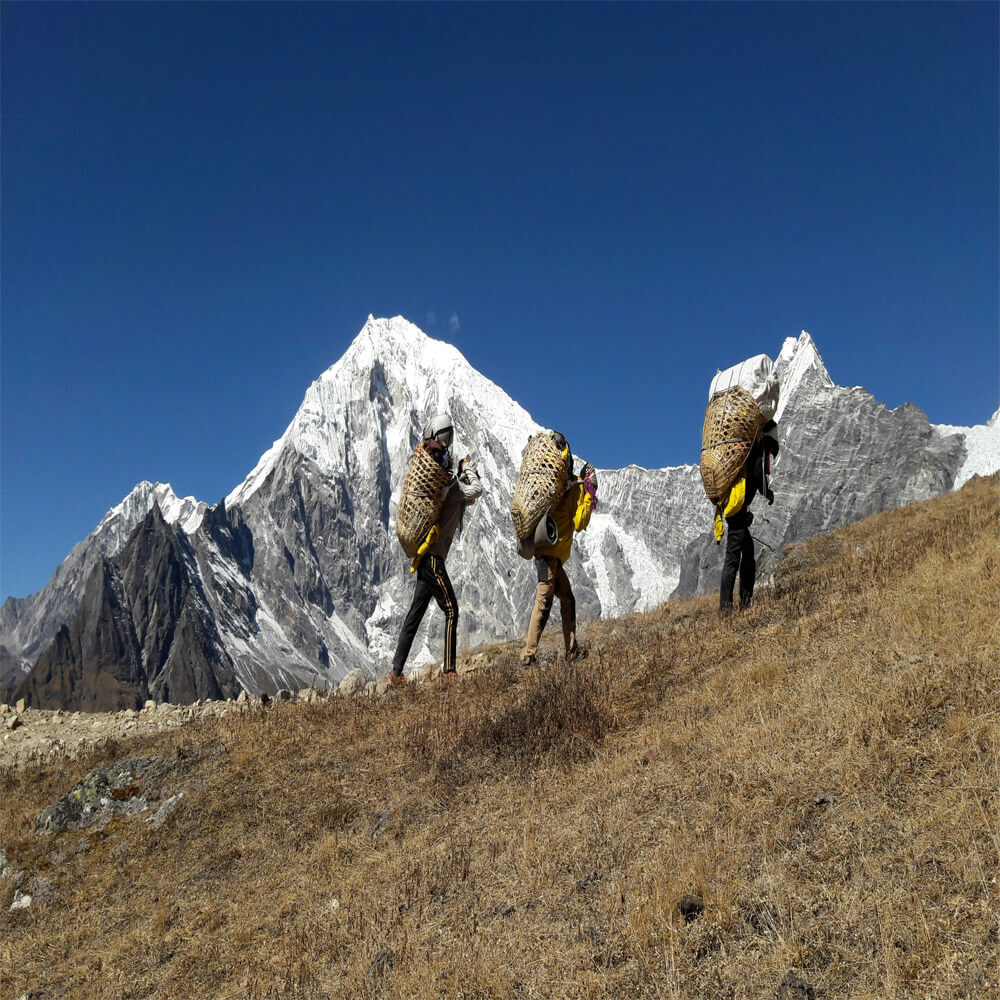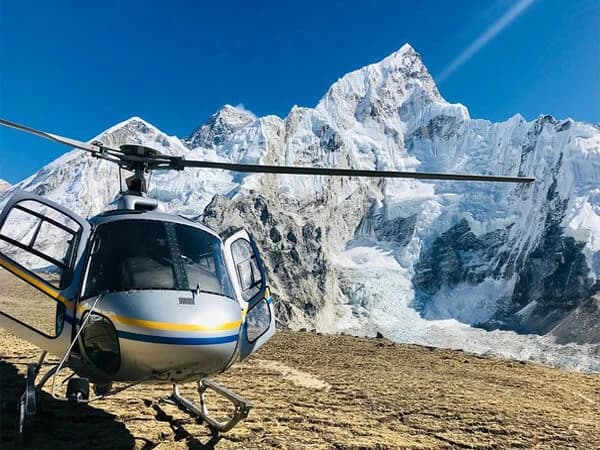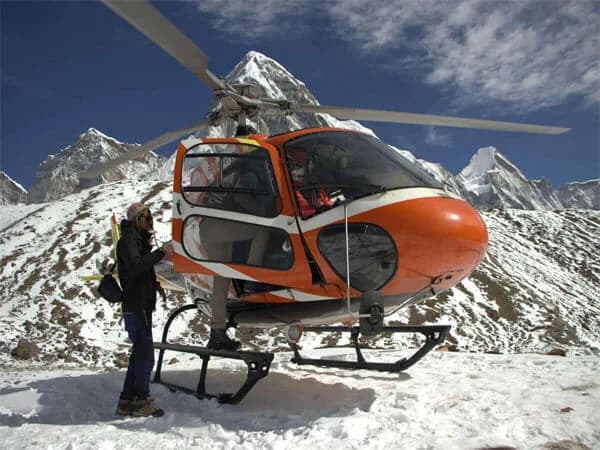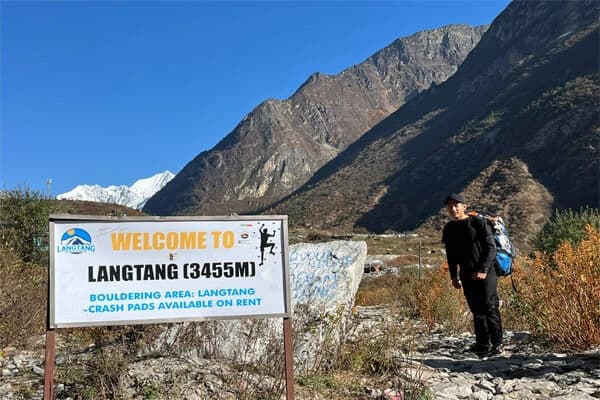The unsung heroes of Himalayan expeditions are the Sherpas of Nepal, who are well-known for their stamina, strength, and in-depth familiarity with high-altitude terrain. They originated in Tibet and have adapted to living in the Everest region by combining Buddhist devotion, rich cultural traditions, and physical resilience. In addition to leading and carrying supplies, Sherpas also guard climbers' safety, negotiate perilous routes, and impart priceless mountain knowledge. Notwithstanding hazards like avalanches and severe weather, they continue to constitute the backbone of Nepal's climbing sector. Their legacy still inspires people today, fusing bravery, culture, and adventure to make them an essential component of the Himalayan experience.
Sherpas of Nepal: The Backbone of Himalayan Expeditions
More than merely mountain guides, the Sherpas of Nepal are the lifeblood of the Himalayas. They have a reputation for being the most hardworking, resilient, and devoted people in the high-altitude areas of eastern Nepal, particularly the area surrounding Everest. Their spiritual and physical ties to the mountains have shaped their remarkable fortitude and composure in the face of the harshness of nature.
For many years, Sherpa climbers have accompanied some of the most well-known mountaineers in the world, securely leading them to the summits of Everest and other Himalayan peaks. The role of Sherpas in mountaineering has been distinguished by their bravery, technical proficiency, and teamwork, making them essential to the accomplishment of almost every significant expedition in Nepal.
Beyond their external accomplishments, however, is a deep tale of community, family, and faith a way of life based on respect for the mountains they consider sacred. This site honors the men and women who have silently carried the burden of the biggest adventures in the world on their shoulders by examining the amazing journey of the Sherpa people, their culture, and their crucial contributions to Himalayan expeditions.
The Origin and Homeland of the Sherpas

In the heart of the Himalayas lies the Sherpa people's story, a dynamic narrative of migration, perseverance, and a profound spiritual bond with the mountains. One must first investigate their origins, culture, and homeland in order to understand their extraordinary contribution to climbing.
The ancient Journey: The History of Sherpas
The history of Sherpas started about 500 years ago when their forefathers moved to Nepal's high valleys from the Kham region of eastern Tibet. They traveled across the high Himalayan ranges in search of lush land and spiritual freedom, eventually settling in the Solukhumbu region, which is close to the foot of Mount Everest. The Tibetan terms Shar, which means "east," and Pa, which means "people," are the origin of their name, "Sherpa," which literally translates to "people from the east."
This was a cultural and spiritual migration, not just a geographic one. The Sherpas carried with them rich oral histories, traditional Tibetan Buddhist customs, and a manner of life that was in harmony with the untamed yet revered mountain landscape. They gained incredible strength and resilience over ages, which eventually proved essential in aiding Himalayan expeditions.
The Sherpas, who lived between 3,000 and 4,500 meters above sea level, adapted to the harsh weather and low oxygen levels. They became renowned Sherpa mountaineers and high-altitude specialists because their bodies evolved to use oxygen more efficiently, which gave them a natural advantage in high-altitude climbing.
Homeland of the Sherpas
The Solukhumbu district in Nepal's northeastern Himalayas is home to the Sherpas. Famous sites including Namche Bazaar, Tengboche Monastery, and Mount Everest known locally as Sagarmatha in Nepali and Chomolungma in Tibetan, which translates to "Mother Goddess of the World" are all located in this area.
Trekkers and climbers traveling to Everest Base Camp gather in Namche Bazaar, the bustling city of the Sherpa. One can sense the vitality of Sherpa life here: monasteries echo with the sound of horns and chants, prayer flags flutter in the wind, and mani stones carved with holy mantras line the trails.
The Sherpas have established prosperous communities among the cliffs and glaciers in spite of the difficult terrain. Their profound respect for the natural world affects every facet of daily existence, ranging from architecture to agriculture. Yak herding, small-scale farming, and stone-built, wooden-framed homes demonstrate their capacity to endure in some of the harshest conditions on earth.
Sherpa Guides for peak climbing in Nepal: Masters of the High Mountains
Travelers now associate the phrase "Sherpa guides Nepal" with safety, competence, and trust. The Sherpas are world-renowned Nepal trekking guides and climbing leaders because of their centuries-long adaption to their harsh country. Climbers all across the world rely on them because of their deep understanding of mountain pathways, weather patterns, and local customs.
Sherpas have been the cornerstone of every successful ascent since Western explorers first started climbing the Himalayas in the early 20th century. They were the backbone of Himalayan climbing support as their responsibilities shifted from porters to expert climbers and expedition leaders. In addition to carrying goods, they often set up camps, repair ropes, and make crucial choices during dangerous climbs.
These Sherpa mountaineers rose to fame in the mountains as brave, modest, and exceptionally talented individuals. The Sherpa community gained international fame thanks to legends like Tenzing Norgay Sherpa, who climbed Mount Everest alongside Sir Edmund Hillary in 1953. In addition to being a personal triumph, his accomplishment served as a testament to the Sherpa's power and Nepal's mountaineering culture.
Life at the Crossroads of Heaven and Earth
The identity of sherpa is defined by their untamed and revered homeland. Every monastery, every mountain, and every route narrates a tale of perseverance and dedication. Their Tibetan heritage and decades of living in the Khumbu region have shaped their distinct personality, which combines hospitality, spirituality, and outstanding mountaineering.
Knowing their origins gives more than just background information to anyone participating Himalayan expeditions or trekking with Sherpa guides in Nepal; it also fosters a deeper sense of appreciation. The Sherpas are more than just tour guides; they are protectors of the Himalayas and strong connections between human bravery, culture, and the natural world.
Sherpa Culture and Lifestyle
The Sherpa people are the heart and spirit of the Himalayas, and they are more than just mountain guides. Their lifestyle, which is firmly based in spirituality, camaraderie, and fortitude, exemplifies how humans and nature can coexist peacefully at high elevations. In addition to their power, the Sherpa community in Nepal has long captivated climbers and tourists with its unique cultural identity and deep respect for the sacred mountains. Beyond their mountaineering accomplishments, we must investigate the Everest Sherpas and their world, including their family, faith, festivals, and daily routines influenced by life in the clouds.
Spiritual Roots in the Mountains
The core of Sherpa culture and customs is faith. Every mountain, rock, and trail has spiritual significance, and most Sherpas are Buddhists of Tibetan descent. Before each climb or trek, Sherpas conduct puja ceremonies, or prayers for safe passage, in front of Buddha statues and under strings of vibrant prayer flags that flutter in the wind. As a reminder to climbers that the Himalayas are alive, breathing protectors of life, these ceremonies are more than just rituals; they are gestures of profound devotion.
Everest and Chomolungma are considered sacred mountains by the Sherpas. They act with humility as a result of this belief. For them, achieving the peak is about respect rather than conquering. Their faith provides them with strength and a sense of purpose, enabling them to navigate the most challenging conditions of high-altitude climbing Nepal, including blizzards, frigid nights, and uncertain routes.
Everyday Life in the Himalayas

The difficulties of surviving in one of the most hostile locations on earth have shaped the Sherpas' straightforward yet tenacious way of life. In traditional Sherpa dwellings, family congregate around cozy hearths made of wood and stone. Typical dishes include butter tea, shyakpa (Sherpa stew), and tsampa (roasted barley flour). Hard work is the norm, whether it is caring for animals, growing small farms, or getting ready for best trekking seasons when tourism boosts their economy.
The Sherpa people are naturally hospitable. Villages like Namche Bazaar, Pangboche, and Khumjung frequently welcome visitors with open arms and friendly grins. As a reflection of the profound values that characterize the Sherpa way of life, sharing tea or a simple meal is a gesture of friendship and gratitude.
Many Sherpa families, in spite of urbanization, still wear in traditional woolen clothing and celebrate ancient rituals with dance, music, and communal feasts. Despite leading seemingly simple lifestyles, they are incredibly content and generous.
Festivals and Celebrations on Sherpas community
Sherpa settlements located throughout the Khumbu Valley experience happiness and unity during festivals. The most lively of the many religious and cultural celebrations held by the Sherpa community Nepal is Mani Rimdu. In remembrance of the founder of Tibetan Buddhism, Guru Rinpoche, this festival honors him with prayers, blessings, and vibrant mask dances at Tengboche Monastery.
Locals and hikers take part in the festival of Sherpas'Mani Rimdu', when monks perform religious dances that symbolize the triumph of good over evil. Chants, drums, and the aroma of incense filling the chilly Himalayan air create a mystical environment. Other significant holidays that honor harmony, thankfulness, and the gifts of nature are Dumji and Losar (Tibetan New Year).
A Culture Intertwined with the Mountains
The Sherpas' connection to the mountains has shaped who they are for many generations. In addition to drawing attention to their strength and expertise, the growth of Mount Everest expeditions demonstrated to the world the Sherpas' profound regard for their natural surroundings. They have generations of experience living in harmony with nature, which has given them unparalleled knowledge of routes, weather, and mountain behavior.
Today, the Everest Sherpas remain a symbol of bravery, humility, and unity as climbers from all over the world travel to Nepal in search of adventure. Their community provides them strength, their traditions serve as a guide, and their faith protects them. The spirit of the "Sherpa culture and traditions" endures in every step they take, whether on the treacherous Khumbu paths or the icy slopes close to the top, serving as a reminder to the world that the Himalayas are more than simply mountains; they are sacred places where people and the natural world coexist.
The Role of Sherpas in Mountaineering
People frequently picture the Himalayas as having tall peaks, whirling snow, and valiant climbers battling their way to the top. The genuine cornerstones of Nepal adventure tourism are the Sherpas, whose calm power and knowledge underpin every successful ascent. Their in-depth familiarity with the landscape, climate, and culture has influenced Himalayan expeditions' safety as well as their essence.
Early Days of Sherpa Involvement in the Mountains
Long before Nepal became open to the outside world, the Sherpas started their mountaineering adventure. Long before it became a career, they lived in the shadow of Everest and frequently climbed and carried cargo across rocky passes. Sherpas' extraordinary endurance and serene disposition at high elevation made them popular choices for porters when British expeditions started exploring Everest in the 1920s.
They became distinguished over time by their dependability, resilience, and upbeat attitude. They evolved into protectors of mountain life rather than merely load-carryers. The Sherpa contribution to mountaineering has maintained its unmatched status from those early expeditions to the commercial climbs of today.
The Role of Sherpas in Everest Climbs
Without the Sherpas, climbing Mt. Everest, the tallest mountain in the world and the ultimate test of human endurance, would be all but impossible. In addition to providing trekkers with guidance, Sherpas play a crucial role in assuring trekkers' survival in one of the most hostile environments on Earth. They set up high camps, repair ropes and ladders, lead the way through the Khumbu Icefall, and carry food supplies and oxygen cylinders often putting their own lives in danger to ensure the success of others.
From modern heroes like Kami Rita Sherpa, who has climbed Everest several times, to Tenzing Norgay, who created history with Sir Edmund Hillary in 1953, their bravery and talent never cease to inspire people. They are essential to each Himalayan adventure because of their serene assurance, which provides every climber strength.
Sherpa Guides in Nepal: The Guardians of Trekkers
Beyond Everest, Sherpa guides are essential on all of Nepal's major trekking routes, including the Manaslu and Gokyo routes and the Annapurna Circuit. They do much more than just carry gear or erect tents; they are mountain interpreters, storytellers, and guardians of those who journey into the unknown.
A genuine "Himalayan trekking experience" involves more than just traversing rocky paths; it also entails getting to know the Sherpa people and learning about their calm discipline, humor, and patience. Each trip is not only an adventure but also a kind of pilgrimage because of their deep respect for the natural world and their spiritual bond with the peaks.
The Spirit of Sherpa Lifestyle and Traditions
The wisdom that the Sherpas have accumulated from generations of mountain living is what makes them so unique, not just their endurance. The core values of the Sherpa lifestyle in the Himalayas are harmony with nature, cooperation, and simplicity. Because they are Buddhists and have a great regard for the land, they consider every mountain, river, and forest to be sacred.
Every expedition is influenced by this way of thinking. Sherpas perform puja rituals to invoke the protection of the mountain gods before to significant ascents. These customs, which are an essential component of Sherpa traditions and Himalayan culture, serve as a reminder to climbers that the mountains should be respected rather than just conquered. The role of Sherpas in mountaineering is genuinely unique because of this fusion of spirituality and expertise.
Sherpas: Unsung Heroes of the himalayas
The world's passion with Himalayan climbing would look considerably different without Sherpas. They represent the virtues of humility, perseverance, and teamwork, and their contribution goes well beyond simple physical effort. They serve as a link between traditional mountain knowledge and the contemporary spirit of discovery that drives Nepal adventure tourism today.
Their presence guarantees that every journey and adventure, whether to the isolated Khumbu valleys or Everest Base Camp, brings a sense of genuineness and concern. They have transformed the highest peaks in the globe into avenues for exploration and human connection.
The Sherpas are real examples of bravery and devotion, not merely porters or guides. Nepal's identity as the home of the Himalayas is still defined by their unwavering spirit, reverence for the natural world, and understanding of the mountains. Their legacy is with you every step of the way through these sacred places.
Challenges Faced by Sherpas
The life of Sherpa climbers in Nepal is one of strength, sacrifice, and silent endurance. Though hailed as Himalayan heroes, they face many dangers and adversities along the way that the general public is frequently unaware of. Every successful summit tale is the result of the unwavering perseverance, bravery, and hard work of these mountain heroes who brave the perils of the highest peaks on earth.
1. The Dangers of High-Altitude Climbing
Everyday risk is a part of life for Sherpas. Carrying heavy loads of food, equipment, and oxygen cylinders sometimes weighing more than 30 kilograms—they operate in high altitudes where oxygen levels drop sharply. They have to make their way through deep crevasses and fragile ice towers, frequently before daylight, on dangerous routes like the Khumbu Icefall on Everest in order to construct safe paths for climbers.
Unfortunately, avalanches, falls, and ailments associated to altitude have claimed the lives of numerous Sherpas. These hazards draw attention to the human cost of the Himalayas' natural splendor. Yet each year, thousands of trekkers and climbers are able to safely realize their ambitions thanks to their courage and talent. The core of Nepal trekking adventures is this reality, where the Sherpas silently take on the biggest risks.
2. Economic Inequality and Recognition
Many Sherpas receive meager pay in comparison to international guides, despite their crucial efforts. Although a climbing season can be profitable, there are unpredictably high risks. Although the Nepal trekking and mountaineering industry brings in a substantial amount of money for the nation, the advantages are not always shared equally.
Sherpas, who enable those ascents, are frequently left in the background as international climbers become famous for reaching the top of Everest. But awareness is rising. These days, groups and travel agencies are pushing for improved insurance, safety instruction, and acknowledgment of Sherpa accomplishments. The world is gradually coming to view them as trained mountaineers and cultural representatives of Nepal's Himalayan spirit, rather than merely as support personnel.
3. Balancing Tradition and Modern Opportunity
Mountaineering and trekking have always been the primary sources of revenue for Sherpa families. Younger generations must decide whether to continue the physically taxing mountain work or to pursue education and new careers in light of modernization. In order to create safer livelihoods while maintaining ties to their history, many increasingly pursue degrees in tourism, commerce, or hospitality.
For many families, mountaineering is still a source of pride. The Khumbu region pridefully tells the tales of dads and grandfathers who served on early expeditions. Climbing is more than simply a career to these families; it is a history of bravery, cooperation, and selflessness. This fusion of modernity and tradition illustrates how the Sherpa community's role in Nepal's future is changing.
4. Emotional and Family Struggles
Every Sherpa climber has a family that is always worried. Many women and kids wait anxiously for weeks when climbing season starts, praying that their loved ones would return safely. Before any journey, communities frequently pray to the mountain gods for blessings.
Although this emotional strain is tremendous, it also makes the Sherpa feel more united and spiritual. For many families, mountaineering is still a source of pride. The Khumbu region pridefully tells the tales of dads and grandfathers who served on early expeditions. Climbing is more than simply a career to these families; it is a history of bravery, cooperation, and selflessness. This fusion of modernity and tradition illustrates how the Sherpa community's role in Nepal's future is changing.
5. Why Sherpas Are Important in Himalayan Expeditions

In actuality, the cornerstone of any Himalayan experience is the Sherpas. Numerous excursions would just not be feasible without their knowledge, power, and deep familiarity with the mountains. They make sure food and supplies reach high altitudes, build up camps, repair ropes, and securely guide climbers through challenging terrain. They are unparalleled in their abilities to recognize weather trends and manage emergencies.
The Nepal trekking and mountaineering industry is much like the lives of Sherpa climbers in Nepal. In many ways, the life of Sherpa climbers in Nepal represents the heart and soul of the Nepal trekking and mountaineering industry. They carry the aspirations of thousands of climbers to the highest peaks in the globe, turning unattainable goals into attainable trips. Sherpas will always be the real heroes of the Himalayas because of their bravery and humility.
Changing Times: Modern Sherpas and Education
The Sherpa people have long been known for their bravery, tenacity, and mountain knowledge. Even while their historical function as porters and guides in Nepal is still highly prized, the modern period has brought with it new chances, difficulties, and growth paths.
How Sherpas people Help Trekkers and Climbers
Sherpas have historically formed the backbone of Himalayan expeditions, skillfully leading climbers through hazardous terrain, erecting camps at high elevations, and guaranteeing climbers' safety in the face of erratic weather. They now play a function that goes beyond providing physical assistance. Trekkers frequently receive logistical preparation, acclimatization advice, and cultural insights from contemporary Sherpas. They assist climbers in navigating the occasionally dangerous Himalayan trails, effectively managing equipment, and getting ready for the demands of high-altitude trekking. Because of their knowledge, they are invaluable in ensuring that travelers enjoy Nepal's natural and cultural diversity while doing so safely.
Famous Sherpa Mountaineers of Nepal
Because of their incredible achievements, numerous Sherpas have gained international recognition over the years. Legends such as Apa Sherpa, who has climbed Everest 21 times, and Tenzing Norgay, who was the first person to summit the peak with Sir Edmund Hillary, are prime examples of Sherpa skill in high-altitude mountaineering. The current generation carries on this tradition by juggling professional mountaineering, worldwide recognition, and involvement in international expeditions with traditional guiding responsibilities. Their accomplishments demonstrate both physical stamina and in-depth mountain expertise, motivating beginner climbers and upholding the Sherpa's standing as top high-altitude experts.
Sherpa Heritage in Nepal Tourism
Sherpas are essential to Nepal's tourist sector in addition to mountaineering. Their festivals, customs, and way of life enhance trekking adventures and provide visitors a genuine taste of Himalayan culture. Pangboche and Namche Bazaar are two villages that highlight Sherpa heritage in Nepal tourism, fusing cultural immersion with adventure. Sherpas are becoming more and more important in luxury trekking packages, cultural tours, and community homestays as guides, educators of local customs, and advocates for eco-friendly travel. Beyond just providing physical labor, they also help to shape tourism narratives and advance sustainable development in isolated areas.
Education and Career Diversification
From international climbing certificates to trekking business, modern Sherpas are increasingly pursuing education and a variety of occupations. Younger generations are now better equipped to assume leadership roles in hospitality, logistics, and guiding thanks to access to schools and higher education. Some have earned certification as Nepal Himalaya trekking guides, fusing traditional wisdom with cutting-edge safety regulations, eco-friendly techniques, and technology. By maintaining their cultural identity and communal values, this progression guarantees that Sherpas will continue to play a significant role in the trekking and climbing sector.
Balancing Tradition and Modernity
The Sherpas are not abandoning their culture in favor of education and career advancement. Many still lead climbers, impart traditional mountaineering skills, and participate in regional celebrations. The community enhances Nepal's standing as a top hiking and climbing destination by fusing Sherpa heritage in Nepal tourism with contemporary abilities. Because of their versatility, trekkers and climbers alike can experience a live culture that respects the mountains and its inhabitants while also gaining access to centuries' worth of accumulated wisdom.
The Sherpa Legacy and Global Respect
In addition to serving as the backbone of Himalayan expeditions, the Sherpas of Nepal have gained international renown as resilient and courageous individuals. Beyond mountaineering, their legacy encompasses sustainable tourism, culture, and community. Knowing what they have contributed helps us understand why they are still so important to the trekking and climbing community.
Trekking Porters and Guides in Nepal
As trekking porters and guides, Sherpas are well known for helping climbers and trekkers navigate some of the world's most difficult terrain. In addition to transporting cargo, they maintain safety by evaluating routes, weather, and other dangers. Their work frequently affects the success of trips, and their deep understanding of the terrain makes them vital. As a testament to their dedication and skill, many Sherpas begin their careers as porters before eventually earning their certification as guides. Their work, frequently done in the face of severe environmental and physical hardship, demonstrates the Sherpas' commitment to both their career and tourists' safety.
Sherpa Training and Skills
Sherpas are skilled in much more than just physical prowess. High-altitude climbing techniques, first-aid knowledge, rescue operations, and navigating perilous mountain routes are all part of the training and skills required of sherpas. Being in harsh environments from an early age teaches them how to interpret weather patterns, recognize avalanche hazards, and safely lead climbers. They combine old knowledge with contemporary mountaineering techniques to pass on their experience to future generations. In order to keep up with international safety requirements and improve their skills, many Sherpas also undergo professional training at mountaineering schools.
Sustainable Tourism in the Himalayas
In the Himalayas, sherpas are essential to the promotion of environmentally friendly travel. They promote eco-friendly trekking methods that have a minimal negative influence on delicate ecosystems, manage waste, and conserve water. Sherpas contribute to the preservation of the mountains for future generations by teaching climbers and hikers about ecological preservation and local culture. By ensuring that tourism benefits local communities without destroying natural resources, they uphold the harmony between environmental stewardship and economic opportunity.
Sherpa Resilience and Bravery
The Sherpa people's fearlessness and tenacity are arguably their most renowned qualities. Sherpas exhibit incredible bravery and tenacity in the face of severe weather, high elevations, and the ongoing threat of avalanches. Climbers all around the world admire them for their capacity to adjust both psychologically and physically to some of the most difficult situations on the planet. Tales of bravery, like saving stranded climbers or attempting several summits, have solidified the Sherpas' standing as the best mountain experts.
To sum up, the Sherpa legacy is diverse and includes knowledge of guiding and porters, skills and training passed down through generations, environmental conservation through sustainable tourism in the Himalayas, and unparalleled bravery and tenacity. In addition to making Himalayan expeditions feasible, their contributions also make them safer, more responsible, and culturally rich. Sherpas have earned their respect on a global scale, and their persistent presence continues to inspire trekkers and adventurers everywhere.
FAQs
1. Who are the Sherpas of Nepal?
Sherpas are an ethnic group originally from Tibet who settled in Nepal centuries ago. They live primarily in the Solukhumbu region, near Mount Everest, and are renowned for their high-altitude adaptability, resilience, and mountaineering skills.
2. Why are Sherpas essential for Himalayan expeditions?
Sherpas serve as guides, porters, and climbing leaders, providing expertise in navigation, weather prediction, and safety. Their knowledge of mountain terrain and logistics ensures successful and secure expeditions, making them indispensable for climbers worldwide.
3. What is unique about Sherpa culture?
Sherpas follow Tibetan Buddhism, celebrate festivals like Mani Rimdu, and live in close-knit communities. Their lifestyle, diet, and traditions are adapted to high-altitude living, blending spirituality with practical survival skills in harsh mountain environments.
4. What challenges do Sherpas face?
Despite their critical role, Sherpas face high-risk work, including avalanches, altitude sickness, and harsh weather. Recognition, fair compensation, and safety remain ongoing concerns in the mountaineering industry.
5. How is modern life changing for Sherpas?
Younger generations are increasingly pursuing education, tourism-related careers, and entrepreneurship. While traditional roles continue, modern opportunities allow Sherpas to balance cultural preservation with economic growth, ensuring their community thrives alongside the evolving Himalayan adventure industry.
Conclusion: Himalayan Expeditions
The Nepalese Sherpas are the backbone of Himalayan expeditions and are much more than just porters or guides. They are able to complete even the most difficult climbs because of their bravery, perseverance, and deep understanding of the mountains. Beyond their physical prowess, their friendliness, warmth, and longstanding Buddhist customs enhance each hike and ascent and provide visitors with an insight into a robust and spiritual way of life. The Sherpa community is essential to maintaining safety and cultural authenticity as climbing continues to draw adventurers from all over the world. In addition to ensuring the success of expeditions, acknowledging their contributions is crucial for paying respect to a people whose lives are inextricably linked to the highest peaks in the world. The Sherpas genuinely capture the essence of the Himalayas.







